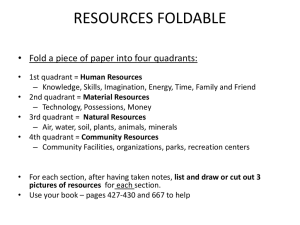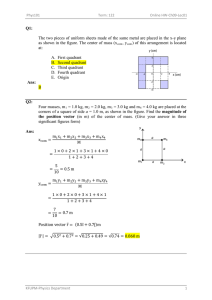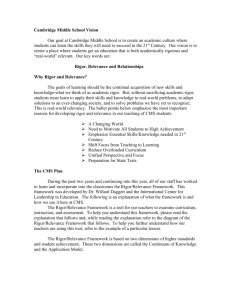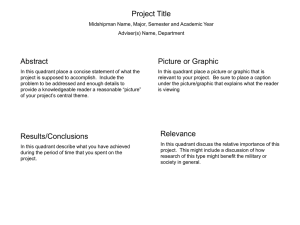Rigor/Relevance Framework®
advertisement
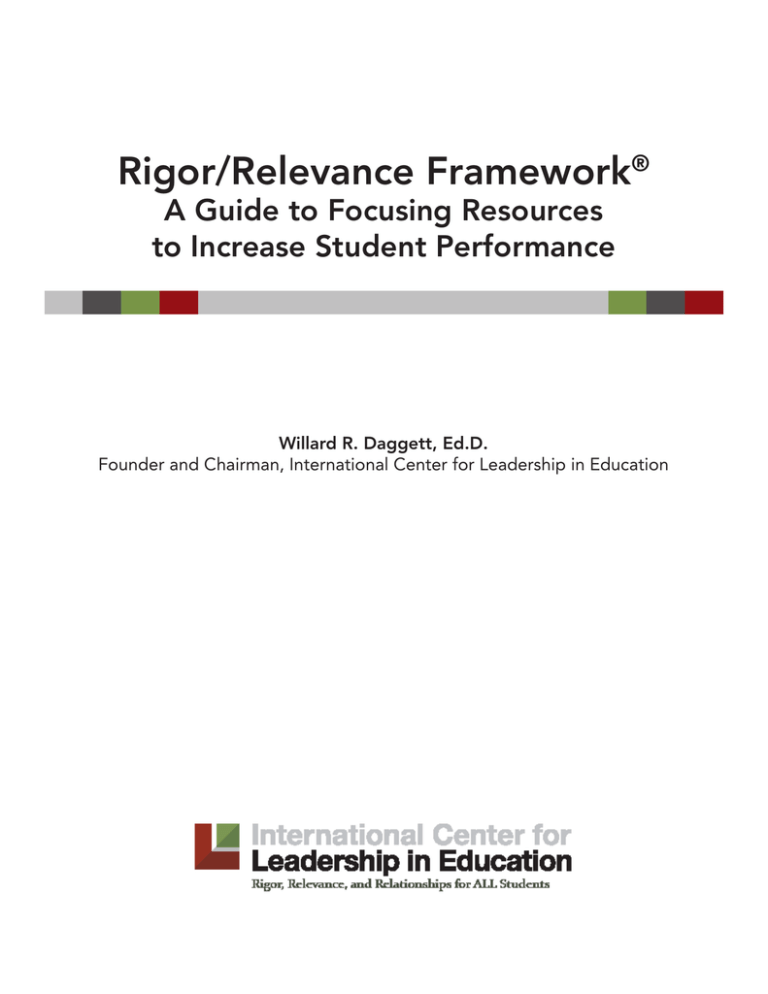
Rigor/Relevance Framework® A Guide to Focusing Resources to Increase Student Performance Willard R. Daggett, Ed.D. Founder and Chairman, International Center for Leadership in Education Rigor/Relevance Framework The Rigor/Relevance Framework® is a tool developed by staff of the International Center for Leadership in Education to examine curriculum, instruction, and assessment. The Rigor/Relevance Framework is based on two dimensions of higher standards and student achievement. First, a continuum of knowledge describes the increasingly complex ways in which we think. This Knowledge Taxonomy is based on the six levels of Bloom’s Taxonomy: 6. 5. 4. 3. 2. 1. Evaluation Synthesis Analysis Application Comprehension Knowledge/Awareness The low end of this continuum involves acquiring knowledge and being able to recall or locate that knowledge in a simple manner. Just as a computer completes a word search in a word processing program, a competent person at this level can scan thousands of bits of information in the brain to locate that desired knowledge. The high end of the Knowledge Taxonomy labels more complex ways in which individuals use knowledge. At this level, knowledge is fully integrated into one’s mind, and individuals can do much more than locate information—they can take several pieces of knowledge and combine them in both logical and creative ways. Assimilation of knowledge is an accurate way to describe this high level of the thinking continuum. Assimilation is often a higher order thinking skill: at this level, the student can solve multi‐step problems, create unique work, and devise solutions. The second continuum, created by Dr. Bill Daggett, is known as the Application Model. The five levels of this action continuum are: 1. Knowledge in 2. Apply in 3. Apply across 4. Apply to real‐ 5. Apply to real‐ one discipline discipline disciplines world world predictable unpredictable situations situations The Application Model describes putting knowledge to use. While the low end is knowledge acquired for its own sake, the high end signifies action—use of that knowledge to solve complex real‐world problems and create projects, designs, and other works for use in real‐world situations. Copyright © 2014 by International Center for Leadership in Education. All rights reserved. 1 The Rigor/Relevance Framework has four quadrants. Quadrant A represents simple recall and basic understanding of knowledge for its own sake. Quadrant C represents more complex thinking but still knowledge for its own sake. Examples of Quadrant A knowledge are knowing that the world is round and that Shakespeare wrote Hamlet. Quadrant C embraces higher levels of knowledge, such as knowing how the U.S. political system works and analyzing the benefits and challenges of the cultural diversity of this nation versus other nations. Quadrants B and D represent action or high degrees of application. Quadrant B would include knowing how to use math skills to make purchases and count change. The ability to access information in wide‐ area network systems and the ability to gather knowledge from a variety of sources to solve a complex problem in the workplace are types of Quadrant D knowledge. Each of these four quadrants can also be labeled with a term that characterizes the learning or student performance. Copyright © 2014 by International Center for Leadership in Education. All rights reserved. 2 Quadrant A — Acquisition Students gather and store bits of knowledge and Technical Reading and information. Students are primarily expected to remember or understand this acquired knowledge. Writing Example Quadrant B — Application Quadrant A—Recall definitions of Students use acquired knowledge to solve problems, various technical terms. design solutions, and complete work. The highest level of application is to apply appropriate knowledge to new and Quadrant B—Follow written unpredictable situations. directions to install new software on a computer. Quadrant C — Assimilation Students extend and refine their acquired knowledge to Quadrant C—Compare and automatically and routinely analyze and solve problems as contrast several technical well as create unique solutions. documents to evaluate purpose, audience, clarity. Quadrant D — Adaptation Students have the competence to think in complex ways Quadrant D—Write procedures for and apply knowledge and skills they have acquired. Even installing and trouble‐shooting when confronted with perplexing unknowns, students are new software. able to use extensive knowledge and skill to create solutions and take action that further develops their skills and knowledge. The Rigor/Relevance Framework is a fresh approach to looking at college‐ and career‐ready standards and assessment. It is based on traditional elements of education, yet encourages movement from acquisition of knowledge to application of knowledge. The framework is easy to understand. With its simple, straightforward structure, it can serve as a bridge between the school and the community. It offers a common language with which to express the notion of a more rigorous and relevant curriculum and encompasses much of what parents, business leaders, and community members want students to learn. The framework is versatile; it can be used in the development of instruction and assessment. Likewise, teachers can measure their progress in adding rigor and relevance to instruction and select appropriate instructional strategies to meet learner needs and higher achievement goals. Defining Rigor A versatile way to define the level of rigor of curriculum objectives, instructional activities, or assessments is the Knowledge Taxonomy Verb List (see page 6). The Verb List can be used either to create a desired level of expected student performance or to evaluate the level of existing curriculum, instruction or assessment. An example of student performance at various levels follows. Notice each statement starts with a verb that comes from the appropriate section of the Verb List. The expected achievement level for teaching about nutrition can vary depending on the purpose of the instruction. If a teacher only wants students to acquire basic nutritional knowledge, a student performance set at level one or two is adequate. If the instruction is intended to have a more significant impact on nutritional habits, then some of the objectives need to be similar to levels four through six. Copyright © 2014 by International Center for Leadership in Education. All rights reserved. 3 Note that each of the levels requires students to think differently. Levels four through six require more complex thinking than levels one through three. When creating lesson plans and student objectives, selecting the proper word from the Knowledge Taxonomy Verb List can help describe the appropriate performance. Simply start with a verb from the desired level and finish the statement with a specific description of that skill or knowledge area. The Verb List can also be used to evaluate existing lesson plans, assessments, and instructional experiences. Looking for verbs and identifying their level will give a good indication of the level of student performance in that instruction. Defining Relevance Defining the level of relevance of curriculum objectives and instructional activities is a little more difficult than determining the Knowledge Taxonomy level because there is no verb list. However, just as the Knowledge Taxonomy categorizes increasing levels of thinking, the Application Model describes increasingly complex applications of knowledge. Any student performance can be expressed as one of five levels of the Application Model. The Application Model Decision Tree (see page 7) can assist in setting the desired level of expected student performance in application by asking the questions: Is it application? Is it real world? Is it unpredictable? The Basic Nutrition example that follows is similar to the one above in that it uses nutrition to describe student performance at various levels. Each level requires students to apply knowledge differently. Similarly, the expected achievement level for teaching about nutrition can vary depending on the purpose of the instruction. If a teacher wants students only to acquire basic nutritional knowledge, a student Copyright © 2014 by International Center for Leadership in Education. All rights reserved. 4 performance set at level one is adequate. If the instruction is intended to have a significant impact on nutritional habits, then some of the objectives need to be at levels four and five. Use of the Decision Tree can help describe desired performance. Start by writing draft statements of student objectives and then use the Decision Tree to reflect on and revise these statements. The Decision Tree focuses on the three key characteristics that distinguish levels of the Application Model: application, real world, and unpredictability. The Decision Tree offers additional criteria to determine whether an objective meets the test of application, real world, and unpredictability. The Decision Tree can also be used to evaluate existing lesson plans, assessments, and instructional experiences. Answer the questions to identify at which level of student performance that instruction or assessment is. Copyright © 2014 by International Center for Leadership in Education. All rights reserved. 5 Copyright © 2014 by International Center for Leadership in Education. All rights reserved. 6 Copyright © 2014 by International Center for Leadership in Education. All rights reserved. 7

